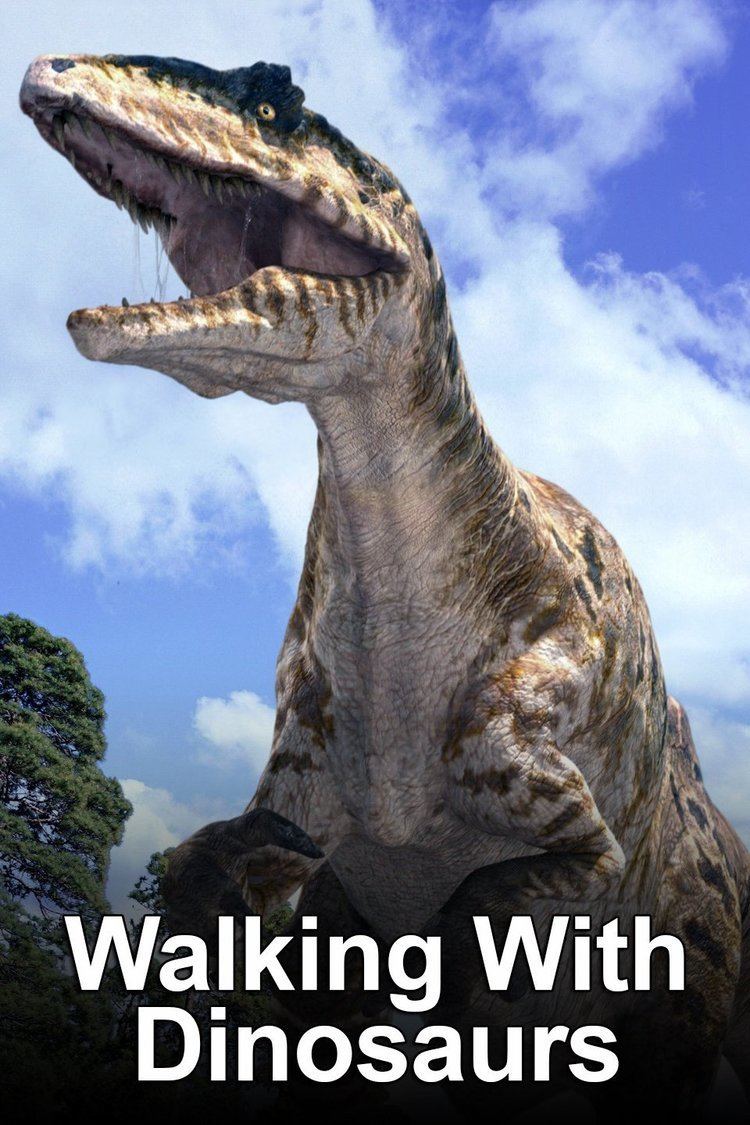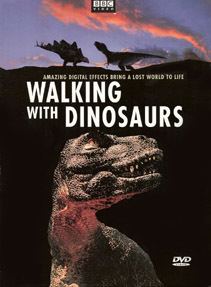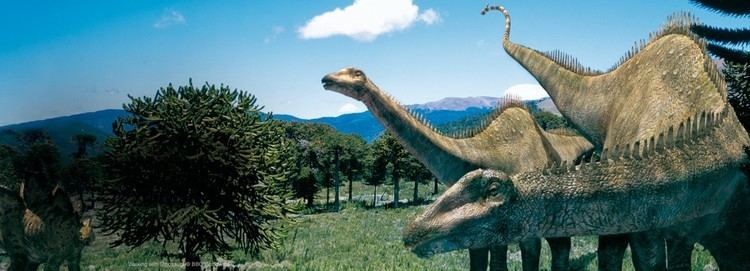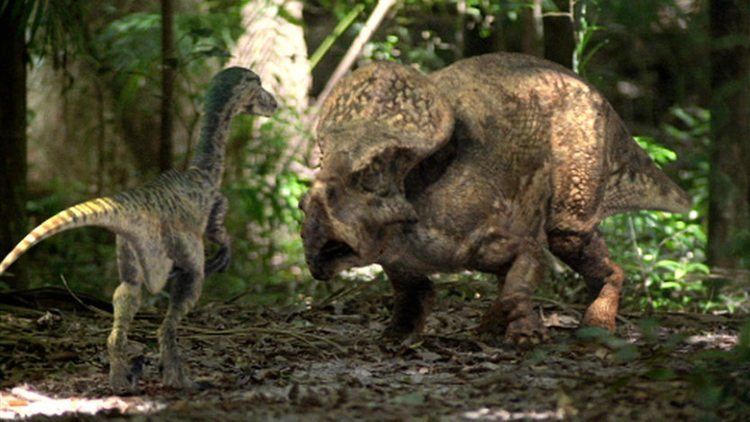9.2 /10 1 Votes
4.9/5 Facebook First episode date 4 October 1999 | 8.6/10 IMDb Creative director(s) Mike Milne Country of origin United Kingdom Final episode date 8 November 1999 | |||||||||||||||||||||||||||||||||
 | ||||||||||||||||||||||||||||||||||
Directed by Tim HainesJasper James Similar Dinosaur Revolution, Prehistoric Planet, Planet Dinosaur, Walking with Beasts, Walking with Monsters Profiles | ||||||||||||||||||||||||||||||||||
Walking with Dinosaurs is a six-part documentary television miniseries created by Tim Haines and produced by BBC Natural History Unit. The series first aired on the BBC in the United Kingdom in 1999 with narration by Kenneth Branagh. The series was subsequently aired in North America on the Discovery Channel in 2000, with Avery Brooks replacing Branagh. The first entry in the Walking with... series, the program explores ancient life of the Mesozoic Era, portraying dinosaurs and their contemporaries in the style of a traditional nature documentary.
Contents
- Benjamin bartlett walking with dinosaurs music from the bbc tv series 1999 full album
- Production
- Scientific accuracy
- Music
- Soundtrack
- Reception
- Companion book
- Live theatrical show
- Film adaptation
- References
Developed by Haines and producer Jasper James, Walking with Dinosaurs recreated extinct species through the combined use of computer-generated imagery and animatronics that were incorporated with live action footage shot at various locations. The Guinness Book of World Records reported that the series was the most expensive documentary series per minute ever produced. The series received critical acclaim, winning two BAFTA Awards, three Emmy Awards and a Peabody Award in 2000. A feature film of the same name, inspired by the series, was released in 2013.

A re-edited version of Walking with Dinosaurs aired on Discovery Kids for the first season of Prehistoric Planet. It was made more appropriate for children by removing most of the graphic content and trimming down some footage to fit the run time.

Benjamin bartlett walking with dinosaurs music from the bbc tv series 1999 full album
Production

Creator Tim Haines contemplated the idea of a dinosaur-centric documentary in 1996, spurred by the resurgence of public interest in prehistoric life following the release of Jurassic Park (1993). Together, with producer Jasper James and effects specialist Mike Milne, Haines shot a six-minute pilot in Cyprus as a proof-of-concept to BBC Worldwide and Discovery Channel for financing. Principal photography took place at a variety of global locations, including Conguillío National Park in Chile, the Redwood National and State Parks in California, New Caledonia, New Zealand, Tasmania, and the Bahamas. Filming consisted of wide landscape shots devoid of any live-action creatures and close-up shots with animatronics.

Since an extensive amount of computer-generated imagery would be necessary in creating the numerous full-size dinosaurs that the project demanded, Haines initially approached Industrial Light & Magic (ILM), the company responsible for creating the visual effects in Jurassic Park. ILM projected a cost of $10,000 per every second of footage featuring a CGI shot, an estimate which BBC deemed too expensive for a television budget. Instead, Haines contracted Framestore, a local British visual effects company to create the CGI elements. Framestore consulted several paleontologists in assisting them with developing natural movements and appearances for the dinosaurs. Michael Benton, Thomas R. Holtz, Jr., Peter Dodson, Peter Larson, Dave Martill, and James Farlow, served as consultants; their influence in the filming process was documented in the companion piece, The Making of Walking with Dinosaurs. The CG work was created over the course of two years.
Scientific accuracy

Michael J. Benton, a consultant to the making of the series and professor of vertebrate palaeontology at the University of Bristol, notes that a group of critics gleefully pointed out that birds and crocodiles, the closest living relatives of the dinosaurs, do not urinate; they shed waste chemicals as more solid uric acid. In the first episode of Walking with Dinosaurs, Postosuchus urinates copiously. However, Benton notes that nobody can prove this was a real mistake: copious urination is the primitive state for tetrapods (seen in fish, amphibians, turtles, and mammals), and perhaps basal archosaurs did the same. He believes many other claims of "errors" identified in the first weeks fizzled out, as the critics had found points about which they disagreed, but they could not prove that their views were correct.
Ornitholestes, a theropod dinosaur of the Late Jurassic, is shown with a small crest atop its head. However, subsequent studies have concluded that it most likely did not have such a crest, and that the misconception that it did came as a result of broken nasal bones in the holotype. Tropeognathus is depicted as far larger than it actually was. In the book based on the series, it was claimed that several large bone fragments from the Santana Formation of Brazil possibly indicate that Tropeognathus may have had a wingspan reaching almost 12 metres and a weight of a hundred kilograms, making it one of the largest known pterosaurs. However, these specimens have not been formally described. The largest definite Tropeognathus specimens known measure 6 metres in wingspan. The specimens which the producers of the program used to justify such a large size estimate are currently undescribed, and are being studied by Dave Martill and David Unwin. Unwin stated that he does not believe this highest estimate is likely, and that the producers likely chose the highest possible estimate because it was more "spectacular." However, no other Early Cretaceous pterosaurs reached its size. Similarly, Liopleurodon is depicted as being 25m long in the series, whereas the adult size known to have been reached by Liopleurodon is around 7m.
Music
Ben Bartlett composed the score for Walking with Dinosaurs. Bartlett was encouraged to accept the duties of composing the series' music at the behest of Haines and James. Bartlett wrote different leitmotifs in separate styles for each episode, citing the different themes and settings presented in each episode as inspiration, elaborating, "I tried to create a different sound world for each episode of Walking With Dinosaurs. That was easy, as they all had different moods. The first episode is all about heat and bloodlust, parched deserts and so on, while the second one was pastoral, peaceful, and beautiful, about dinosaurs living in symbiosis with the forests. And so on."
The recording process took place at Angel Studios in Islington, with four sessions scattered over the early months of 1999. The score was recorded by the BBC Concert Orchestra. During these sessions, Bartlett admitted to being enriched with experience by the task, stating, "It was the biggest orchestral endeavour I've ever undertaken, and I learnt so much from the first session. Practical things, like handing out the parts to the players before the session, numbering pages... tiny logistical things that can really screw up a session."
Soundtrack
Ben Bartlett's original score for Walking with Dinosaurs was released by BBC Music on CD on April 11, 2000.
All music composed by Ben Bartlett.
Reception
Walking with Dinosaurs received critical acclaim following its initial broadcast. The series won two BAFTAs for Innovation and Best Original Television Music and earned six Primetime Emmy Award nominations, winning for Outstanding Animated Program, Outstanding Special Visual Effects and Outstanding Achievement in Non-Fiction Programming – Sound Editing. In a list of the 100 Greatest British Television Programmes drawn up by the British Film Institute in 1999, voted on by industry professionals, Walking with Dinosaurs was placed 72nd.
Common Sense Media praised the program, giving it five stars out of five and saying that, "Somebody had a great idea, which was to make a documentary series about dinosaurs, but with a twist. The aging Tropeognathus on a desperate final flight to his mating grounds, the sauropod hatchlings struggling for survival in the late Jurassic, the migrating herds and the undersea life of 150 million years ago would all seem as real as a nature program about polar bears or snow monkeys." This technique of narrating the prehistoric life as though it were current has been used several times since, for example in the BBC's 2011 Planet Dinosaur series.
Companion book
A companion book was written by Tim Haines to accompany the first screening of the series in 1999. The settings of some of the six episodes were changed between the time the book was written and the screening of the television series, and some of their names were changed: 'New Blood' is set at Ghost Ranch; 'Cruel Sea' is set at or near Solnhofen in Germany near what then were the Vindelicisch Islands. The book elaborated on the background for each story, went further in explaining the science on which much of the program is based, and included descriptions of several animals not identified or featured in the series.
Live theatrical show
Walking with Dinosaurs: The Arena Spectacular is a live theatrical show adaptation and travelling exhibition of the series that originated in Australia in January 2007 (as Walking with Dinosaurs: The Live Experience), and toured North America in 2007–10, Europe in 2010, and returned to North America until 2011. It also toured Asia beginning in December 2010. In 2011 the show came to its final destination of its first tour, New Zealand. In 2012, the show toured the UK, Germany, Ireland, Norway, Sweden, Denmark, Finland, and the Netherlands.
Featured species:
Film adaptation
Released in 2013, Walking with Dinosaurs is a feature-length film about dinosaurs in the Late Cretaceous period 70 million years ago. The production features computer-animated dinosaurs in live-action settings with actors John Leguizamo, Justin Long, Tiya Sircar, and Skyler Stone providing voiceovers for the main characters. It was directed by Neil Nightingale and Barry Cook from a screenplay by John Collee.
The film was produced by BBC Earth and Evergreen Films and was named after the original BBC miniseries. The film, with a budget of US$80 million, was one of the largest independent productions to date; it was financed by Reliance Entertainment and IM Global, with 20th Century Fox handling distribution. The crew filmed footage on location in the U.S. state of Alaska and in New Zealand, which were chosen for their similarities to the dinosaurs' surroundings millions of years ago. Animal Logic designed computer-animated dinosaurs and added them to the live-action backdrop. Though the film was originally going to have a narrator like in the miniseries, Fox executives wanted to add voiceovers to connect audiences to the characters.
Walking with Dinosaurs premiered on 14 December 2013 at the Dubai International Film Festival. It was released in cinemas in 2D and 3D on 20 December 2013. Critics commended the film's visual effects but found its storytelling to be sub-par and derided the voiceovers as juvenile. The film grossed US$34.4 million in the United States and Canada and US$71.6 million in other territories for a worldwide total of US$106 million. The Hollywood Reporter said the film's global box office performance was disappointing in context of the production budget and marketing spend.
